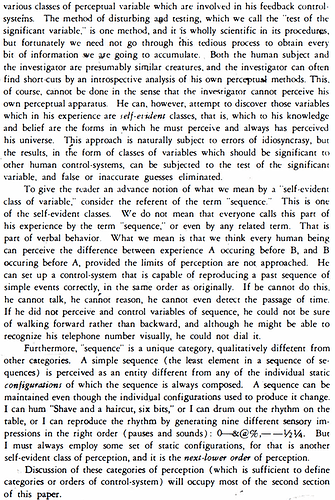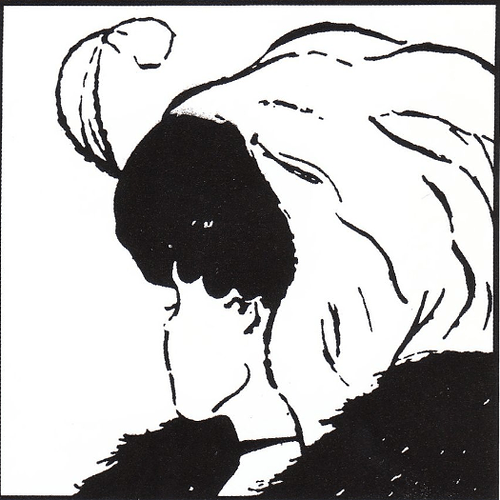Martin Taylor 2019.04.14.09.50]
[Rick Marken 2019-04-13_12:07:31]
the concept of an RREV is unnecessary atbest and an impediment to the development of PCT as a science at
worst.
[Rick Marken 2019-04-13_18:26:37]
RM: I think what you call an RREV is what I would call thecollection of physical variables that are the basis of a
perception.
Accuracy is not measured in terms of how
well the description of the controlled variable matches an
imagined RREV. So, again, the concept of an RREV is unnecessary at
best and an impediment to the development of PCT as a science at
worst.
I guess if you define and RREV as "* the collection of physical
variables that are the basis of a perception* " and think of it
as “imagined”, I can easily see how you could say “* the concept of
an RREV is unnecessary at best and an impediment to the
development of PCT as a science at worst.”* And I would agree
with you whole-heartedly, But what you think I call an RREV is not
much like what I do call an RREV.
When I introduced the term (not the concept, which was already
there), I did not define it in that way, nor did I suggests that it
could be imagined. You can imagine anything you like, but nothing
you imagine will ever be an RREV. An RREV just is, an entity in the
Real Reality we presume to exist.
Let me see if an example might help explain what I meant by an RREV
(and at the same time suggest why evolution might have come up with
a perceptual control hierarchy rather than a flat, one-level set of
myriads of control systems that independently controlled their
perceptions of “* the collection of physical variables that are the
basis of a* [MT. higher than sensor-level] *perception”.
- -------example--------
Consider a wooden chair*.* It has four wooden legs, a flat
square wooden seat and a back constructed of a set of wooden slats.
For the purposes of this example, I assume that we have basic
sensors for legs, seat, and back, as the example could work for any
one of the components, and for any one of their components. So for
the example, a leg is an elementary unit of perception.
I push one of the legs northward. To my surprise (because I know
there is no chair in Real Reality) each of the other legs starts
moving northward by itself, and so do the seat and back, which are
not legs at all. How can this be, I ask myself? What kind of magic
tells these other perceptions I call legs, seat and back to move all
by themselves? Do they really, or is it all an illusion. I know that
one leg moved because I pushed it and changes in my perception of
its location coincided with feelings of pressure on my hand as I
pushed it. But, since the other bits and pieces are just a
“collection of physical variables” that hang together only because I
have a perception of “chair”, why should they move along with the
one whose location perception I was controlling?
Aha! I say after some thought. Maybe it's not magic. Maybe there
really is something “out there in Real Reality” that functions so as
to make all these parts hang together. Maybe in Real Reality a band
of gnomes has been handed a set of instructions ordering them to
keep these “chair parts” in a constant spatial relationship to each
other as any one part is moved by an outside agency of which they
know nothing. The gnomes are simply collectively controlling a
configuration of these parts. That solves the problem. These gnomic
reference values create in Real Reality what I perceive as the chair
in the “Apparent World” of my perceptions.
A problem. I'm just imagining that there are gnomes. It's a possible
solution to my problem of why I perceive all the different chair
parts moving together when I push only one of them, but is it the
only possible solution? Probably not, so would it not be better to
think more generally and not ask at this point the mechanism that
holds all the chair parts together. We can leave that to other
people who can imagine abstractions such as forces and energies that
they could apply to many similar puzzles of perceptions that always
seem to change similarly in respect of their interactions. The
“forces” these other people imagine to exist in Real Reality can
take the place of the gnomes, and I would perceive no difference in
how I perceive the whole chair to move when I push one leg
northward.
The "chair" is a structure in RR, whether it is held together by
gnomes, forces, or some other magic. Whatever it is, I need not
imagine it, however much fun it is to do so. All I need is that
because these components always act the same way when I push one of
them, it is easiest to think of them as one object. I perceive that
I move the “chair” when I try to move one of the chair’s components.
Now I push one chair leg northward, the seat southward, another leg
westward, and so forth, which I assume I should easily be able to do
because, after all, I know that they are just the collection of
physical variables that are the basis of my “chair” perception. But
I get another surprise. The unit components all resist my pushes.
Maybe the chair trembles a little and moves erratically in a
direction I pushed none of them. What’s happening? Maybe the gnomes
are angry at being overworked trying to follow their instructions
and finding those instructions to be self-contradictory? Whatever is
happening in Real Reality, its effects on the perceptions of the
units are not what I am controlling for. The seat does not move
southward, the two legs do not move northward and westward, and so
on.
How can I solve this new puzzle? All I know is that my answer for
what might be happening in RR, that some properties of RR (gnomes of
forces, maybe) enforce a structure with a particular configuration
that allows no movement freedom of the individual components
independently of their places in the “chair” configuration I
perceive.
---------end example-------
In the example, the location of the "chair" configuration I perceive
is what I call the CEV when I control my perception of its position.
It is totally determined by the perceptual function that generates
“chair” from a collection of “legs”, “seat”, and “back” perceptions.
The configuration of instructions for the gnomes or the disposition
of forces (or something else) is a “structure” in Real Reality that
I call the RREV. The RREV is what is influenced by my actions and it
produces the effects in my sensor systems that allow me to perceive
at one level “legs”, “seat”, and “back”, and at a higher level
“chair”.
This does not mean that every time I perceive "chair" there is a
Real Reality chair affecting my sensors. I might be looking at a
drawing of a chair, I might be dreaming, I might be hallucinating.
If, then, I try to sit on the chair I perceive, I will not
experience what I expect to experience (though in a dream I probably
would). If, however, most of the time when I perceive “chair” its
components interact in the same way, whether there is a Real Reality
structure or a collection of components will affect me differently
only if I try to use the “chair” structure in controlling some other
variable such as a seating arrangement for my guests.
The RR configuration that results in the "chair" perception may be a
structure maintained by gnomes, or it may be an adventitious
arrangement of independent components. either way, it is the RREV
that corresponds with the perceived CEV. The Real Reality structure,
if one exists, is likely to have many other properties besides the
NSEW locations of its components, but the sensors and the “chair”
perceptual function in the example are affected by changes in none
of them. In this sense, the RREV, like the CEV, is defined by the
Perceptual Function. However, the Perceptual Function itself is
evolved or reorganized to be what it is because when the components
are configured as what comes to be perceived as “chair”, they
usually change in a coordinated function – they usually act as a
unitary Real Reality Environmental Variable, a structure in RR, and
seldom as “* the collection of physical variables that are the
basis of a perception.*”
Martin

